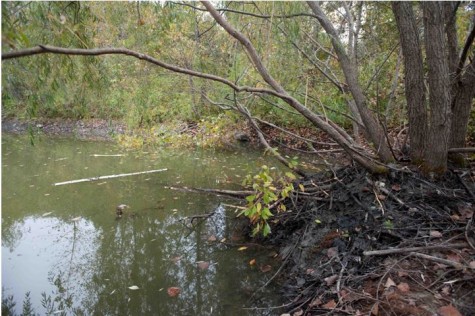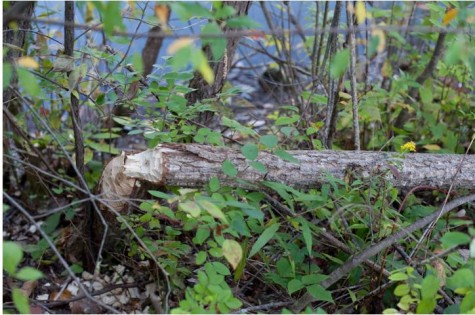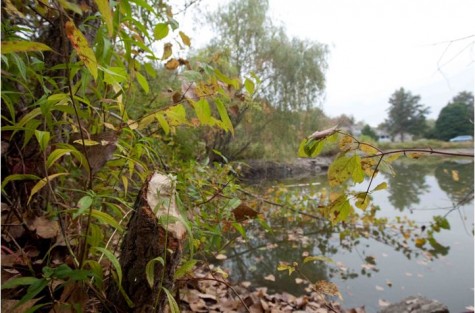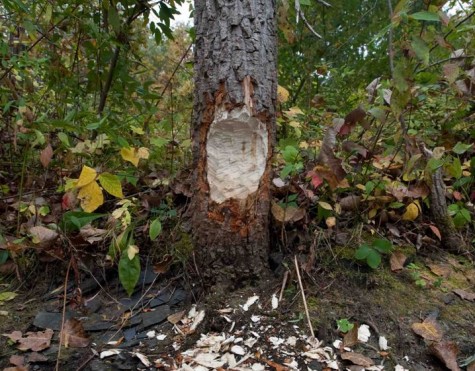 I have a beaver, which I am going to kill, which is a complex thing to do. The beaver moved into a small pond on my property a month after I moved from Brooklyn. I came 100 miles, the beaver had to move less than a mile, coming from wetlands that border part of my property. Beavers are not known to travel much more than that.
I have a beaver, which I am going to kill, which is a complex thing to do. The beaver moved into a small pond on my property a month after I moved from Brooklyn. I came 100 miles, the beaver had to move less than a mile, coming from wetlands that border part of my property. Beavers are not known to travel much more than that.
The pond is small and roughly rectangular, about half an acre. Two of its sides are ringed with trees. Those sides are where the action is. Frogs, snakes, voles, mice, birds, raccoons, and hedgehogs fight for room.
 Two weeks ago, near midnight, I was photographing frogs on the pond’s edge, sitting under a bright moon. The beaver announced itself with a loud slap of its tail on the water, a sound I mistook for a bass jumping.
Two weeks ago, near midnight, I was photographing frogs on the pond’s edge, sitting under a bright moon. The beaver announced itself with a loud slap of its tail on the water, a sound I mistook for a bass jumping.
The sound repeated within a few minutes, only louder. Bass don’t jump like that.
The beaver was swimming across the pond, head out, its teeth reflecting in the light from my flashlight. It made five or six laps, staring straight ahead. Ok, beaver, I get it, you can swim fast. It then slipped under the water. Gone.
Beyond the beaver, floating in the middle of the pond, was a branch about fifteen feet long, still with the orange leaves of early fall.
Earlier in the day I had found a small tree, perhaps six feet tall, its trunk about 2 inches in diameter, lying across the footpath in the further woods that rings the pond. I cleared it away, confused that wind had knocked it down.
I had a beaver. I was content. This is why I had moved out of Brooklyn.
 That a beaver was on my land, only miles from the Hudson River, wouldn’t have been surprising at any time in history, except for the last 300 years. Prior to the arrival of Europeans beavers were ubiquitous to the Hudson Valley. It was the supply of beavers that motivated the Europeans to colonize.
That a beaver was on my land, only miles from the Hudson River, wouldn’t have been surprising at any time in history, except for the last 300 years. Prior to the arrival of Europeans beavers were ubiquitous to the Hudson Valley. It was the supply of beavers that motivated the Europeans to colonize.
New Amsterdam (now New York City) was founded in 1626 for trading beaver furs. Beavers were trapped in present-day Albany (Fort Orange), shipped to New Amsterdam, and then shipped to Amsterdam, to become hats. By 1750 the beavers were largely gone, over-hunted. New York City was still a trading center, but for sugar and other commodities (and slaves). It wasn’t until the early 1900s with the passage of laws regulating trapping that beavers started returning. And it wasn’t until the last thirty years that they returned enough to spill onto land like mine.
 My beaver was more than spilling, it was settling, building a home under the roots of a willow tree that loomed over the back corner of the pond.
My beaver was more than spilling, it was settling, building a home under the roots of a willow tree that loomed over the back corner of the pond.
Small gaps started appearing in the wall of foliage that defines the pond. Gaps emptied except for one-foot high spikes fashioned from tree trunks. The upper part of the trees were scattered. Some smaller pieces floated in the water, like bones, stripped stark white. Others lay atop the growing lodge, joining new layers of mud and leaves, mixing with the willow tree’s roots.
I started worrying, and started watching more, hoping that fewer gaps would appear. At night the beaver’s bulk could be seen on the pond’s bank, a dark blob reaching towards branches. Other times it would be swimming, towing a branch slowly.
 Gaps continued to appear. Five nights, five new gaps. The wall of green and orange that delineated half the edge of my pond, that I never considered, now seemed finite and fragile. I started noticing and caring about individual trees, saplings, and bushes. Started to care what types of trees they were, since beavers have preferences. Aspen, cottonwood, willow and dogwood I was told, are their favorites. I had cottonwood, oaks, and maples. And a willow tree that it had chosen to live beneath.
Gaps continued to appear. Five nights, five new gaps. The wall of green and orange that delineated half the edge of my pond, that I never considered, now seemed finite and fragile. I started noticing and caring about individual trees, saplings, and bushes. Started to care what types of trees they were, since beavers have preferences. Aspen, cottonwood, willow and dogwood I was told, are their favorites. I had cottonwood, oaks, and maples. And a willow tree that it had chosen to live beneath.
I read about beavers. There was no webpage with a neutral view of beavers; everyone came with a decided beaver agenda. Either they were cute spirit animals, sacrosanct in North America, or they were unctuous minions of the devil who needed to be exterminated.
My family named it Mr. Busy, so I focused on how to deal with it humanely. I tried placating it. There were recently fallen maples in the woods on the other side of my property. I hauled one across the yard and threw it near the lodge. The next day it floated, untouched.
Zoos feed their beavers lettuce and apples. I tossed my beaver a head of lettuce. The next day I saw it floating untouched.
More branches, freshly and precisely ripped from the shoreline, continued to appear, lying on the pond’s bank, half eaten, or floating next to the lodge. I started waking afraid, not wanting to look.
Beavers can do only finite damage, I thought, but the size of damage they can do is an appreciable percentage of trees I have. And they have two kits a year, so it was going to be a bigger problem fast. The beaver was morphing, changing from a swimming cat into a caricature of the personalities I had left in Manhattan: Selfish, single-minded, and competent.
 The beaver was screwing with me, making me worry and care about trees. Something I had never cared much about before. Trees. Just damn trees. They provide cover for mice and snakes and frogs and bugs and butterflies and, well, everything. And beavers like to eat them. I was ready to kill the damn thing.
The beaver was screwing with me, making me worry and care about trees. Something I had never cared much about before. Trees. Just damn trees. They provide cover for mice and snakes and frogs and bugs and butterflies and, well, everything. And beavers like to eat them. I was ready to kill the damn thing.
I focused on my options, calling wildlife management. Live trapping and transporting the beaver is illegal. Letting the beaver stay, or killing it are the only options. I would have to file for a nuisance license, which gives me permission to kill the beaver. I couldn’t shoot it, another house is within 500 feet, but I could trap it. I couldn’t sell the pelt. That can only be done after trapping season, which starts on November 7. I read about trappers and trapping and selling pelts and the National Trappers convention and the live markets for pelts and the price of pelts and the North American Fur Auctions (NAFA). “Beaver prices were very poor. The low prices of both beaver and wild mink (which didn’t do great either) are likely tied to a huge drop in ranch mink prices. Raccoon and bobcat prices didn’t exactly tank, but were lower than previous levels. Otter held up okay.” My beaver’s pelt was worth between $6.10 and $26.82.
The details of trapping, of the clamps and hoops that catch legs, of drowning, of piles of dead beavers laying in an auction room didn’t fit my family’s narrative for Mr. Busy. I tried one last time to accommodate the beaver.
 I found a pro-beaver chat forum composed of mostly cute beavers (avatars don’t lie) discussing natural solutions for beavers. I bought industrial size portions of vegetable oil and cayenne pepper to mix and paint on the trees. A natural solution that led me to spend a natural afternoon painting the trunks of 40 trees dark red to a height that an outstretched beaver might reach, a height determined by naturally using my outstretched cat, an outstretched cat who naturally scratched me.
I found a pro-beaver chat forum composed of mostly cute beavers (avatars don’t lie) discussing natural solutions for beavers. I bought industrial size portions of vegetable oil and cayenne pepper to mix and paint on the trees. A natural solution that led me to spend a natural afternoon painting the trunks of 40 trees dark red to a height that an outstretched beaver might reach, a height determined by naturally using my outstretched cat, an outstretched cat who naturally scratched me.
 Overnight the beaver chewed through one smaller red tree, and found one of many smaller trees I hadn’t been able to reach with my paintbrush. I realized that what once looked vast was really only a handful of now very fragile trees. Trees that were holding the life of the pond together.
Overnight the beaver chewed through one smaller red tree, and found one of many smaller trees I hadn’t been able to reach with my paintbrush. I realized that what once looked vast was really only a handful of now very fragile trees. Trees that were holding the life of the pond together.
I was done.
 I drove to the Department of Environmental Conservation Division of Fish, Wildlife and Marine Resources and received Permit Number 3-14-375, “Permit to take or harass nuisance or destructive wildlife.”
I drove to the Department of Environmental Conservation Division of Fish, Wildlife and Marine Resources and received Permit Number 3-14-375, “Permit to take or harass nuisance or destructive wildlife.”
For $850 a licensed pest control specialist will come to my property, set a trap, and hope to snare and kill the beaver.
After twenty years working as a banker in New York City, a city founded because of beavers, I had quit my job and moved to the country. Where I ended up with a beaver. A beaver that was reminding me of a banker, a furry large-teethed banker. A beaver that was impressively clever and competent. A beaver that left unchecked would reshape the pond for its own interest. A beaver with a particularly destructive and controlling form of selfishness.
So I will kill this beaver. And I won’t feel any guilt. Hardly any.
___________
Chris Arnade received his PhD in physics from Johns Hopkins University in 1992. He spent the next 20 years working as a trader on Wall Street. He left trading in 2012 to focus on photography. His “Faces of Addiction” series explores addiction in the south Bronx. Follow him on Twitter: @Chris_arnade
__________
All photos by Chris Arnade
Wish you luck with the next beaver…
Killing may only be a temporary solution – try feeding the next beaver from the beginning and find out what your beaver really likes if you value your trees…
Hmm, maybe the Beaver will become too big to fail and require a government bail-out!
After you kill it, will you have it stuffed? Then you can put it on the wall and all your old (male) buddies from wall street can come visit and exclaim, “Nice Beaver!”
This is the best dam story I have read lately.
Did you consider an air rifle? Air rifles are not firearms and so are often not subject to restrictions like the 500′ rule you mention. For $850, you could certainly get a gun that would humanely exterminate this beaver and any future beavers.
Bow and arrow? Crossbow?
Beavers are only a nuisance because they don’t conform to your New York banker vision of what your natural paradise should be. Beaver ponds create wetlands which are among the most biologically productive ecosystems in the world. They increase plant, bird and wildlife variety, and improve water quality. By opening the tree canopy, sunlight reaches the water and triggers an explosion of biological activity. Algae and aquatic plants grow in the sun drenched, nutrient rich water. This organic material supports microscopic organisms, which are eaten by a variety of invertebrates. These become food for fish, birds and mammals. An entire food chain is created in a beaver pond. The trees which they are impacting on your yard on not threatened, but many of the species that the beaver supports are…
I hope you reconsider. Beavers are not the pests that you claim, and though they do have their challenges, they are really improving your watershed.
Beavers are really “worth a dam”.
You cannot kill that beaver! Bad karma to kill him/her.
i wood have to agree. the beaver is innocent here. banker be damned!
With the Fed, ECB, and BOJ all cranking up the printing press, debasing and devaluing paper money in a “race to the bottom”, beaver pelts are something that I know will keep going up in value. I recommend trapping as many beavers as you can get, and keeping the pelts as an investment.
What precocious little fellow…courage to both of you! I can’t help but wonder of our (human) justification of deforestation…if this little guy could talk he would sound just like man.